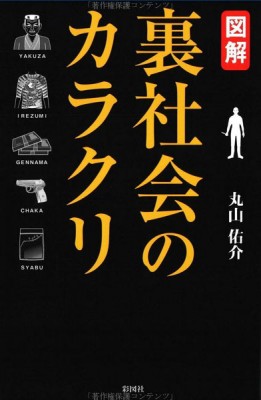Purposely vague, shadowy and difficult to understand, the Japanese underworld is a puzzling and ever-changing realm of secrecy, even for those who study it. There’s no quick-and-dirty tutorial or handbook for learning about the seedier side of life (there is, however, OJT–a different topic all together), and while it’s simple for some gifted purveyors of all that creeps between the cracks of society to just dive right in, some of us need to take things slow and get our bearings before dipping our toes into the sleaze and corruption.
 But fear not, fellow students, because there is a way in. 図解裏社会のカラクリ (Zukai Urashakai no Karakuri – Illustrated Guide to How the Underworld Works) documents the ABCs of the “anti-social” world in easy-to-manage two-page bites, one page covering a topic in relatively simple Japanese then summing up the key points with textbook-worthy illustrations on the facing page. The concept is simple and works for the broad range of topics available, from the down and dirty on yakuza traditions to how the ghouls and ghosts of the ura shakai have their fun.
But fear not, fellow students, because there is a way in. 図解裏社会のカラクリ (Zukai Urashakai no Karakuri – Illustrated Guide to How the Underworld Works) documents the ABCs of the “anti-social” world in easy-to-manage two-page bites, one page covering a topic in relatively simple Japanese then summing up the key points with textbook-worthy illustrations on the facing page. The concept is simple and works for the broad range of topics available, from the down and dirty on yakuza traditions to how the ghouls and ghosts of the ura shakai have their fun.
The first chapter does indeed begin with Japanese organized crime groups, laying out simply the hierarchy of organizations, “A day in the life” of an underling and a kumi-cho, and how exactly that whole pinky finger thing works. I actually received this book after lamenting about seemingly archaic customs harboring unusual words like sakazuki and gobun kyodai. But there it is, laid out all nicely in the first section. Ever wondered what kind of duds an Armani-wearing yak might sport on the weekend? What the layout of a typical office might look like? Where gangsters get their guns? All covered in easy to understand brevity.
Zukai Urashakai no Karakuri goes even further in the section section, hitting up lesser-known but just as intriguing points under the surface of society, like the legal boundaries of private investigators, the difference between right wingers and left wingers, and the business cycle of peeping tom tosatsu videos. “Do assassins really exist?” the question is posed atop one of the illustrated pages. Yes, the book says, and they’re oftentimes foreigners who can escape penalties for the crime by returning to their home country.
Underworld entertainment–sex, drugs, rock n’ roll with a splash of gambling–is covered in the last section. The invasion of Japanese ladies into foreign streetwalkers’ territory, the affects of drug addiction, fake DVDs, even the Shinjuku gay district. Each entry is written very matter-of-factly, neither condoning nor criticising, and graciously avoids being as detailed as a “how to” book while still providing a decent explanation. The beauty is that Zukai covers not those nitty-gritty things one would normally feel apprehensive about asking a local, but actually things your average Taro would have no idea about. A quick flip through would do wonders for impressing your friends with intimate knowledge of underworld trivia–as long as you don’t mind coming off as a creep.
Admittedly, though, finding some of the vocab used here was a pain in the ass, both uncommon terms and slang. Even with a normal dictionary, Zukai isn’t exactly a book to read while relaxing in the park (especially if you’re self conscious about getting strange glances) and is best done with an Internet connection nearby. Although this certainly isn’t oriented towards an audience that would typically need it, a smear of furigana would have been appreciated here and there. What the book really needs is a quick-lookup glossary in the back with things like 破門回状 and マルチ商法. Small complaints, though, considering Zukai was written for native Japanese speakers with little to no knowledge of the underworld.
This is a book that, as you read it, you’d wish someone had made something just as fun to peruse for your own country. I’m waiting for a follow-up, perhaps some special editions that go into further detail about uyoku, the geino-kai, perhaps something about this ‘wave’ of foreign crime Japan seems to be constantly experiencing. Or perhaps, if Jake can pick up an illustrator, that will be our next project here at JSRC?
Thanks for the info and link. Looks interesting to say the least.
Fantastic. Someone translate it please!
I agree with Karen, this book sounds amazing and fascinating. I hope that it gets an English translation soon.